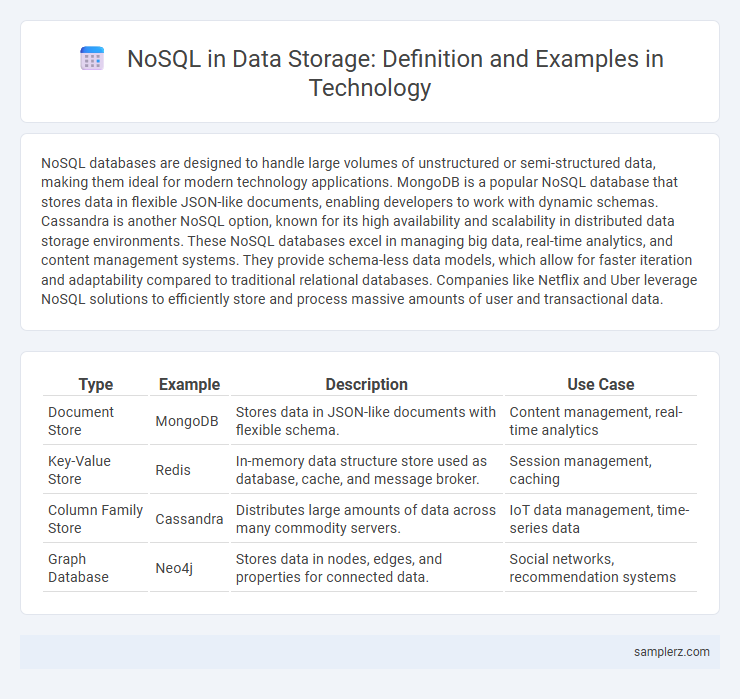NoSQL databases are designed to handle large volumes of unstructured or semi-structured data, making them ideal for modern technology applications. MongoDB is a popular NoSQL database that stores data in flexible JSON-like documents, enabling developers to work with dynamic schemas. Cassandra is another NoSQL option, known for its high availability and scalability in distributed data storage environments. These NoSQL databases excel in managing big data, real-time analytics, and content management systems. They provide schema-less data models, which allow for faster iteration and adaptability compared to traditional relational databases. Companies like Netflix and Uber leverage NoSQL solutions to efficiently store and process massive amounts of user and transactional data.
Table of Comparison
| Type | Example | Description | Use Case |
|---|---|---|---|
| Document Store | MongoDB | Stores data in JSON-like documents with flexible schema. | Content management, real-time analytics |
| Key-Value Store | Redis | In-memory data structure store used as database, cache, and message broker. | Session management, caching |
| Column Family Store | Cassandra | Distributes large amounts of data across many commodity servers. | IoT data management, time-series data |
| Graph Database | Neo4j | Stores data in nodes, edges, and properties for connected data. | Social networks, recommendation systems |
Introduction to NoSQL in Modern Data Storage
NoSQL databases such as MongoDB, Cassandra, and Redis have revolutionized modern data storage by providing flexible schemas and horizontal scalability. These databases efficiently handle unstructured and semi-structured data, making them ideal for big data applications and real-time web analytics. Their distributed architecture supports high availability and fault tolerance, essential for cloud-native environments and large-scale applications.
Key Features of NoSQL Databases
NoSQL databases such as MongoDB, Cassandra, and Redis offer key features including flexible schema design, horizontal scalability, and high availability. These databases support diverse data models like document, column-family, and key-value stores, enabling efficient handling of unstructured and semi-structured data. Their fault-tolerant architecture and distributed nature ensure rapid performance and seamless data replication across multiple nodes.
Document-Oriented NoSQL Storage: MongoDB Example
MongoDB is a leading example of document-oriented NoSQL storage, designed for high scalability and flexibility in handling semi-structured data. It stores data in JSON-like BSON format, enabling dynamic schemas and efficient querying for complex hierarchical data. MongoDB's powerful aggregation framework and horizontal scaling capabilities make it ideal for modern applications requiring rapid development and real-time analytics.
Key-Value Stores: Redis and Its Data Storage Capabilities
Redis is a high-performance key-value store renowned for its in-memory data storage and rapid read/write operations, making it ideal for caching, real-time analytics, and session management. It supports diverse data structures such as strings, hashes, lists, sets, and sorted sets, enabling flexible and efficient data manipulation. Redis persistence options, including snapshotting and append-only files, ensure durability without compromising speed in scalable NoSQL environments.
Wide-Column Stores: Using Apache Cassandra in Data Storage
Apache Cassandra exemplifies a wide-column store NoSQL database designed for handling large volumes of data across distributed systems with high availability and fault tolerance. Its data model organizes information into tables, rows, and dynamic columns, allowing efficient queries on massive datasets with flexible schema design. Cassandra's scalability and decentralized architecture make it ideal for real-time analytics, IoT data management, and large-scale applications requiring low latency and high write throughput.
Graph Databases: Neo4j for Complex Relationship Storage
Neo4j is a leading graph database designed for storing and querying complex relationship data in technology applications. It uses a property graph model to efficiently manage interconnected nodes and edges, enabling advanced data analysis and real-time recommendation systems. Graph databases like Neo4j excel in scenarios where relationships between entities are more critical than the entities themselves, such as social networks, fraud detection, and knowledge graphs.
Real-World Applications Leveraging NoSQL Databases
NoSQL databases such as MongoDB, Cassandra, and Redis are extensively utilized in real-world applications for handling large-scale, unstructured data across diverse industries. MongoDB powers dynamic content management and real-time analytics in e-commerce platforms, while Cassandra supports high availability in global financial transaction systems. Redis is widely adopted for caching and session management in social media and gaming applications, enabling low-latency user experiences.
Comparing NoSQL Types in Data Storage Solutions
Document-based NoSQL databases like MongoDB excel at storing semi-structured data with flexible schemas, making them ideal for content management and real-time analytics. Key-value stores such as Redis offer lightning-fast access and efficient caching for session management and gaming leaderboards. Column-family stores like Apache Cassandra provide high availability and scalability, handling large volumes of write-intensive workloads in IoT and time-series data applications.
Scalability and Flexibility with NoSQL Data Storage
NoSQL data storage solutions such as MongoDB, Cassandra, and Couchbase excel in scalability and flexibility by allowing horizontal scaling across distributed clusters, which efficiently handles large volumes of unstructured and semi-structured data. These databases support diverse data models, including document, key-value, and wide-column formats, enabling agile schema design that adapts to evolving application requirements without downtime. The ability to perform high-speed read and write operations with eventual consistency models ensures optimal performance in cloud-native and big data environments.
Choosing the Right NoSQL Database for Your Needs
Selecting the ideal NoSQL database depends on the specific use case, data model, and scalability requirements. Document-based databases like MongoDB excel in handling complex, hierarchical data structures, while key-value stores such as Redis offer high-speed caching and real-time analytics. Graph databases like Neo4j provide efficient management of interconnected data, making them suitable for social networks and recommendation systems.

example of nosql in data storage Infographic
 samplerz.com
samplerz.com